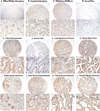Detection of human polyomavirus proteins, T-antigen and agnoprotein, in human tumor tissue arrays
- PMID: 20336718
- PMCID: PMC2861297
- DOI: 10.1002/jmv.21514
Detection of human polyomavirus proteins, T-antigen and agnoprotein, in human tumor tissue arrays
Abstract
Expression of the human polyomavirus JCV genome in several experimental animals induces a variety of neural origin tumors. The viral proteins, T-antigen and Agnoprotein, contribute to the oncogenesis of JCV by associating with several tumor suppressor proteins and dysregulating signaling pathways, which results in uncontrolled cell proliferation. In addition, T-antigen and Agnoprotein have been associated with DNA damage and interfering with DNA repair mechanisms. In this study, we have utilized commercially available tissue arrays of human tumors of various origins and demonstrated the expression of both T-antigen and Agnoprotein in some, but not all, tumors of neural and non-neural origin. Most notably, more than 40% of human glioblastomas and greater than 30% of colon adenocarcinomas express viral proteins. The detection of viral transforming proteins, T-antigen and Agnoprotein in the absence of viral capsid proteins suggests a role for JCV in the development and/or progression of human tumors. These results invite further large-scale investigation on the role of polyomaviruses, particularly JCV in the pathogenesis of human cancer.
(c) 2010 Wiley-Liss, Inc.
Figures


Similar articles
-
Expression of human neurotropic polyomavirus JCV late gene product agnoprotein in human medulloblastoma.J Natl Cancer Inst. 2002 Feb 20;94(4):267-73. doi: 10.1093/jnci/94.4.267. J Natl Cancer Inst. 2002. PMID: 11854388
-
Detection of JC virus DNA sequences and expression of viral T antigen and agnoprotein in esophageal carcinoma.Cancer. 2005 Feb 1;103(3):516-27. doi: 10.1002/cncr.20806. Cancer. 2005. PMID: 15630684
-
The agnoprotein of polyomaviruses: a multifunctional auxiliary protein.J Cell Physiol. 2005 Jul;204(1):1-7. doi: 10.1002/jcp.20266. J Cell Physiol. 2005. PMID: 15573377 Review.
-
Potential mechanisms of the human polyomavirus JC in neural oncogenesis.J Neuropathol Exp Neurol. 2008 Aug;67(8):729-40. doi: 10.1097/NEN.0b013e318180e631. J Neuropathol Exp Neurol. 2008. PMID: 18648329 Free PMC article. Review.
-
Dephosphorylation of JC virus agnoprotein by protein phosphatase 2A: inhibition by small t antigen.Virology. 2008 Jun 5;375(2):464-79. doi: 10.1016/j.virol.2008.02.020. Epub 2008 Mar 18. Virology. 2008. PMID: 18353419 Free PMC article.
Cited by
-
JC polyomavirus in the aetiology and pathophysiology of glial tumours.Neurosurg Rev. 2016 Jan;39(1):47-53. doi: 10.1007/s10143-015-0676-5. Epub 2015 Nov 12. Neurosurg Rev. 2016. PMID: 26560882
-
Human Polyomavirus JC monitoring and noncoding control region analysis in dynamic cohorts of individuals affected by immune-mediated diseases under treatment with biologics: an observational study.Virol J. 2013 Sep 30;10:298. doi: 10.1186/1743-422X-10-298. Virol J. 2013. PMID: 24079660 Free PMC article.
-
JCV agnoprotein-induced reduction in CXCL5/LIX secretion by oligodendrocytes is associated with activation of apoptotic signaling in neurons.J Cell Physiol. 2012 Aug;227(8):3119-27. doi: 10.1002/jcp.23065. J Cell Physiol. 2012. PMID: 22034072 Free PMC article.
-
Human Polyomavirus JCPyV and Its Role in Progressive Multifocal Leukoencephalopathy and Oncogenesis.Front Oncol. 2019 Aug 8;9:711. doi: 10.3389/fonc.2019.00711. eCollection 2019. Front Oncol. 2019. PMID: 31440465 Free PMC article. Review.
-
New insights on human polyomavirus JC and pathogenesis of progressive multifocal leukoencephalopathy.Clin Dev Immunol. 2013;2013:839719. doi: 10.1155/2013/839719. Epub 2013 Apr 17. Clin Dev Immunol. 2013. PMID: 23690827 Free PMC article. Review.
References
-
- Behzad-Behbahani A, Klapper PE, Vallely PJ, Cleator GM, Khoo SH. Detection of BK virus and JC virus DNA in urine samples from immunocompromised (HIV-infected) and immunocompetent (HIV-non-infected) patients using polymerase chain reaction and microplate hybridization. J Clin Virol. 2004;29:224–229. - PubMed
-
- Bendiksen S, Rekvig OP, Van Ghelue M, Moens U. VP1 DNA sequences of JC and BK viruses detected in urine of systemic lupus erythematosus patients reveal no differences from strains expressed in normal individuals. J Gen Virol. 2000;81:2625–2633. - PubMed
-
- Ben-Ezra J, Johnson DA, Rossi J, Cook N, Wu A. Effect of fixation on the amplification of nucleic acids from paraffin-embedded material by the polymerase chain reaction. J Histochem Cytochem. 1991;39:351–354. - PubMed
-
- Berger JR, Concha M. Progressive multifocal leukoencephalopathy: The evolution of a disease once considered rare. J Neurovirol. 1995;1:5–18. - PubMed
-
- Bhattacharrya R, Noch EK, Khalili K. A novel role of Rac1 GTPase in JCV T-antigen mediated β-catenin stabilization. Oncogene. 2007;26:7628–7636. - PubMed
Publication types
MeSH terms
Substances
Grants and funding
LinkOut - more resources
Full Text Sources
Other Literature Sources

